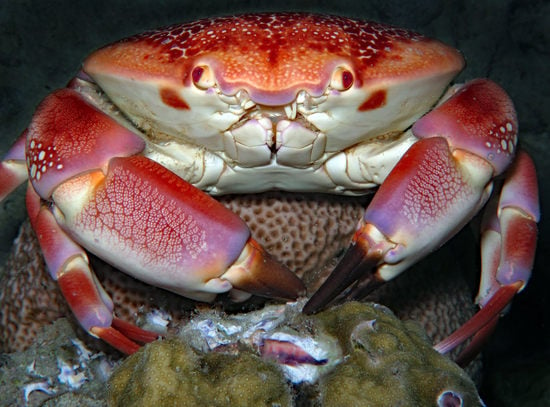Nocturnal Predation of Christmas Tree Worms by a Batwing Coral Crab at Bonaire (Southern Caribbean)
Supplementary Materials
Author Contributions
Funding
Acknowledgments
Conflicts of Interest
References
- Hoeksema, B.W.; ten Hove, H.A. The invasive sun coral Tubastraea coccinea hosting a native Christmas tree worm at Curaçao, Dutch Caribbean. Mar. Biodivers. 2017, 47, 59–65. [Google Scholar] [CrossRef] [Green Version]
- Perry, O.; Sapir, Y.; Perry, G.; ten Hove, H.; Fine, M. Substrate selection of Christmas tree worms (Spirobranchus spp.) in the Gulf of Eilat, Red Sea. J. Mar. Biol. Assoc. UK 2018, 98, 791–799. [Google Scholar] [CrossRef] [Green Version]
- Nishi, E.; Nishihira, M. Age-estimation of the Christmas tree worm Spirobranchus giganteus (Polychaeta, Serpulidae) living buried in the coral skeleton from the coral-growth band of the host coral. Fish. Sci. 1996, 62, 400–403. [Google Scholar] [CrossRef] [Green Version]
- García-Hernández, J.E.; Hoeksema, B.W. Sponges as secondary hosts for Christmas tree worms at Curaçao. Coral Reefs 2017, 36, 1243. [Google Scholar] [CrossRef]
- Hoeksema, B.W.; García-Hernández, J.E.; van Moorsel, G.W.N.M.; Olthof, G.; ten Hove, H.A. Extension of the recorded host range of Caribbean Christmas tree worms (Spirobranchus spp.) with two scleractinians, a zoantharian, and an ascidian. Diversity 2020, 12, 115. [Google Scholar] [CrossRef] [Green Version]
- Hoeksema, B.W.; van der Schoot, R.J.; Wels, D.; Scott, C.; ten Hove, H.A. Filamentous turf algae on tube worms intensify damage in massive Porites corals. Ecology 2019, 100, e2668. [Google Scholar] [CrossRef] [PubMed]
- Hoeksema, B.W.; Wels, D.; van der Schoot, R.J.; ten Hove, H.A. Coral injuries caused by Spirobranchus opercula with and without epibiotic turf algae at Curaçao. Mar. Biol. 2019, 166, 60. [Google Scholar] [CrossRef] [Green Version]
- Böhm, T.; Hoeksema, B.W. Habitat selection of the coral-dwelling spinyhead blenny, Acanthemblemaria spinosa, at Curaçao, Dutch Caribbean. Mar. Biodivers. 2017, 47, 17–25. [Google Scholar] [CrossRef] [Green Version]
- Hoeksema, B.W.; ten Hove, H.A. Attack on a Christmas tree worm by a Caribbean sharpnose pufferfish at St. Eustatius, Dutch Caribbean. Bull. Mar. Sci. 2017, 93, 1023–1024. [Google Scholar] [CrossRef]
- Woods, C.M.C. Natural diet of the crab Notomithrax ursus (Brachyura: Majidae) at Oaro, South Island, New Zealand. N. Z. J. Mar. Freshw. Res. 1993, 27, 309–315. [Google Scholar] [CrossRef]
- Pequegnat, L.H.; Ray, J.P. Crustaceans and other arthropods. In Biota of the West Flower Garden Bank; Bright, T.J., Pequegnat, L.H., Eds.; Gulf Publishing: Houston, TX, USA, 1974; pp. 231–288. [Google Scholar]
- Wetzer, R.; Martin, J.W.; Trautwein, S.E. Phylogenetic relationships within the coral crab genus Carpilius (Brachyura, Xanthoidea, Carpiliidae) and of the Carpiliidae to other xanthoid crab families based on molecular sequence data. Mol. Phylogenet. Evol. 2003, 27, 410–421. [Google Scholar] [CrossRef]
- Vermeij, G.J. Interoceanic differences in vulnerability of shelled prey to crab predation. Nature 1976, 220, 135–136. [Google Scholar] [CrossRef]
- Aspe, N.M.; Cabales, R.G.; Sajorne, R.E.; Creencia, L.A. Survey on the predators of abalone Haliotis asinina from the perspective of the local fisherfolks in selected sites of Palawan, the Philippines. J. Shellfish Res. 2019, 38, 463–473. [Google Scholar] [CrossRef]
- Zipser, E.; Vermeij, G.J. Crushing behaviour of tropical and temperate crabs. J. Exp. Mar. Biol. Ecol. 1978, 31, 155–172. [Google Scholar] [CrossRef]
- Laughlin, R.A. Some observations on the occurrence, reproduction and mating of the coral crab Carpilius corallinus (Herbst, 1783) (Decapoda, Xanthidae) in the Archipielago Los Roques, Venezuela). Crustaceana 1982, 43, 219–221. [Google Scholar] [CrossRef]

Publisher’s Note: MDPI stays neutral with regard to jurisdictional claims in published maps and institutional affiliations. |
© 2020 by the authors. Licensee MDPI, Basel, Switzerland. This article is an open access article distributed under the terms and conditions of the Creative Commons Attribution (CC BY) license (http://creativecommons.org/licenses/by/4.0/).
Share and Cite
Muller, E.; de Gier, W.; ten Hove, H.A.; van Moorsel, G.W.N.M.; Hoeksema, B.W. Nocturnal Predation of Christmas Tree Worms by a Batwing Coral Crab at Bonaire (Southern Caribbean). Diversity 2020, 12, 455. https://doi.org/10.3390/d12120455
Muller E, de Gier W, ten Hove HA, van Moorsel GWNM, Hoeksema BW. Nocturnal Predation of Christmas Tree Worms by a Batwing Coral Crab at Bonaire (Southern Caribbean). Diversity. 2020; 12(12):455. https://doi.org/10.3390/d12120455
Chicago/Turabian StyleMuller, Ellen, Werner de Gier, Harry A. ten Hove, Godfried W. N. M. van Moorsel, and Bert W. Hoeksema. 2020. "Nocturnal Predation of Christmas Tree Worms by a Batwing Coral Crab at Bonaire (Southern Caribbean)" Diversity 12, no. 12: 455. https://doi.org/10.3390/d12120455
APA StyleMuller, E., de Gier, W., ten Hove, H. A., van Moorsel, G. W. N. M., & Hoeksema, B. W. (2020). Nocturnal Predation of Christmas Tree Worms by a Batwing Coral Crab at Bonaire (Southern Caribbean). Diversity, 12(12), 455. https://doi.org/10.3390/d12120455






